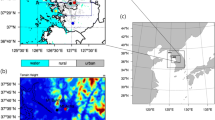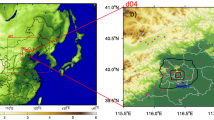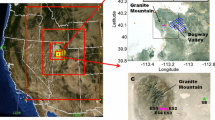Abstract
We tested several planetary-boundary-layer (PBL) schemes available in the Weather Research and Forecasting (WRF) model against measured wind speed and direction, temperature and turbulent kinetic energy (TKE) at three levels (5, 9, 25 m). The Urban Turbulence Project dataset, gathered from the outskirts of Turin, Italy and used for the comparison, provides measurements made by sonic anemometers for more than 1 year. In contrast to other similar studies, which have mainly focused on short-time periods, we considered 2 months of measurements (January and July) representing both the seasonal and the daily variabilities. To understand how the WRF-model PBL schemes perform in an urban environment, often characterized by low wind-speed conditions, we first compared six PBL schemes against observations taken by the highest anemometer located in the inertial sub-layer. The availability of the TKE measurements allows us to directly evaluate the performances of the model; results of the model evaluation are presented in terms of quantile versus quantile plots and statistical indices. Secondly, we considered WRF-model PBL schemes that can be coupled to the urban-surface exchange parametrizations and compared the simulation results with measurements from the two lower anemometers located inside the canopy layer. We find that the PBL schemes accounting for TKE are more accurate and the model representation of the roughness sub-layer improves when the urban model is coupled to each PBL scheme.















Similar content being viewed by others
References
Bisignano A, Ferrero E, Alessandrini S, Mortarini L (2017) Model chain for buoyant plume dispersion. Int J Env Poll 62(2/3/4):200–213
Bougeault P, Lacarrere P (1989) Parametrization of orography-induced turbulence in a mesobeta-scale model. Mon Weather Rev 117(8):1872–1890
Byggstoyl S, Kollmann W (1986) A closure model for conditioned stress equations and its application to turbulent shear flows. Phys Fluids 29:1430–1440
Canuto V (1992) Turbulent convection with overshootings: reynolds stress approach. J Astrophys 392:218–232
Canuto V, Dubovikov M, Yu G (1999) A dynamical model for turbulence. IX: reynolds stresses for shear-driven flows. Phys Fluids 11:678–691
Canuto V, Howard A, Cheng Y, Dubovikov M (2001) Ocean turbulence part I: one-point closure model momentum and heat vertical diffusivities. J Phys Oceanogr 31:1413–1426
Canuto V, Cheng Y, Howard A (2005) What causes divergences in local second-order models? J Atmos Sci 62:1645–1651
Chang JC, Hanna SR (2004) Air quality model performance evaluation. Meteorol Atmos Phys 87:167–196
Chen F, Mitchell K, Schaake J, Xue Y, Pan H, Koren Duan Y, Ek M, Betts A (1996) Modeling of land-surface evaporation by four schemes and comparison with FIFE observations. J Geophys Res 101:7251–7268
Chen F, Kusaka H, Bornstein R, Ching J, Grimmond CSB, Grossman-Clarke S, Loridan T, Manning KW, Martilli A, Miao S, Sailor D, Salamanca FP, Taha H, Tewari M, Wang X, Wyszogrodzkia AA, Zhangh C (2011) The integrated WRF/urban modelling system: development evaluation and applications to urban environmental problems. Int J Climatol 31:273–288
Cheng Y, Canuto V (1994) Stably stratified shear turbulence: A new model for the energy dissipation length scale. J Atmos Sci 51:2384–2396
Cheng Y, Canuto V, Howard A (2005) Non-local convective PBL model based on new third- and fourth-order moments. J Atmos Sci 62:2189–2204
Colonna NM, Ferrero E, Rizza U (2009) Nonlocal boundary layer: The pure buoyancy-driven and the buoyancy-shear-driven cases. J Geophys Res Atmos 114:148–227
Coniglio MC, Correia J, Marsh P, Patrick T, Kong F (2013) Verification of convection-allowing WRF model forecasts of the planetary boundary layer using sounding observations. Weather Forecast 28(3):842–862
Deardorff J (1972) Theoretical expression for the countergradient vertical heat flux. J Geophys Res 77:5900–5904
Dimitrova R, Silver Z, Zsedrovits T, Hocut CM, Leo LS, Di Sabatino S, Fernando HJS (2016) Assessment of planetary boundary-layer schemes in the Weather Research and Forecasting mesoscale model using MATERHORN field data. Boundary-Layer Meteorol 159(3):589–609
Durbin P (1993) A Reynolds stress model for near wall turbulence. J Fluid Mech 249:465–498
Ferrero E (2005) Third-order moments for shear driven boundary layers. Boundary-Layer Meteorol 116:461–466
Ferrero E, Colonna N (2006) Nonlocal treatment of the buoyancy-shear-driven boundary layer. J Atmos Sci 63:2653–2662
Ferrero E, Racca M (2004) The role of the non-local transport in modelling the shear-driven atmospheric boundary layer. J Atmos Sci 61:1434–1445
Garcìa-Dìez M, Fernandez J, Fita L, Yagüe C (2013) Seasonal dependence of WRF model biases and sensitivity to PBL schemes over Europe. Q J R Meteorol Soc 139(671):501–514
Gryanik V, Hartmann J, Raasch S, Schoroter M (2005) A refinement of the Millionschikov quasi-normality hypothesis for convective boundary layer turbulence. J Atmos Sci 62:2632–2638
Hamdia R, Schayes G (2008) Sensitivity study of the urban heat island intensity to urban characteristics. Int J Climatol 28:973–982
Holtslag A, Boville B (1993) Local versus non-local boundary layer diffusion in a global climate model. J Clim 6:1825–1842
Holtslag A, Moeng C (1991) Eddy diffusivity and countergradient transport in the convective atmospheric boundary layer. J Atmos Sci 48:1690–1700
Hong S, Noh Y, Dudhia J (2006) A new vertical diffusion package with an explicit treatment of entrainment processes. Mon Weather Rev 134(9):2318–2341
Hu X-M, Nielsen-Gammon JW, Zhang F (2010) Evaluation of three planetary boundary layer schemes in the WRF model. J Appl Meteorol Climatol 49:1831–1843
Janjic ZI (1990) The step-mountain coordinate: physical package. Mon Weather Rev 118(7):1429–1443
Janjic ZI (2001) Nonsingular Implementation of the Mellor-Yamada Level 25 Scheme in the NCEP Meso model. Technical report. National Center for Environmental Prediction, College Park, p 61
Jones W, Musange P (1988) Closure of the Reynolds stress and scalar flux equations. Phys Fluids 31:3589–3604
Kleczek M, Steeneveld GJ, Holtslag A (2014) Evaluation of the Weather Research and Forecasting mesoscale model for GABLS3: impact of boundary-layer schemes boundary conditions and spin-up. Boundary-Layer Meteorol 152:213–243
Luhar AK, Hurley PJ, Rayner KN (2009) Modelling near-surface low winds over land under stable conditions: sensitivity tests flux-gradient relationships and stability parametrs. Boundary-Layer Meteorol 130:249–274
Martilli A, Clappier A, Rotach MW (2002) An urban surface exchange parametrisation for mesoscale models. Boundary-Layer Meteorol 104:261–304
Mellor GL, Yamada T (1974) A hierarchy of turbulence closure models for planetary boundary layers. J Atmos Sci 31:1791–1806
Mellor G, Yamada T (1982) Development of a turbulence closure model for geophysical fluid problems. Rev Geophys 20:851–875
Miguez-Macho G, Stenchikov GL, Robock A (2004) Spectral nudging to eliminate the effects of domain position and geometry in regional climate model simulations. J Geophys Res 109:D13104
Moeng C, Sullivan P (1994) A comparison of shear- and buoyancy-driven planetary boundary layer flows. J Atmos Sci 51:999–1022
Moeng C, Wyngaard J (1989) Evaluation of turbulent transport and dissipation closures in second-order modelling. J Atmos Sci 46:2311–2330
Monti P, Fernando HJS, Princevac M, Chan WC, Kowalewski TA, Pardyjak ER (2002) Observations of flow and turbulence in the nocturnal boundary layer over a slope. J Atmos Sci 59:2513–2534
Mortarini L, Ferrero E, Richiardone R, Falabino S, Anfossi D, Trini Castelli S, Carretto E (2009) Assessment of dispersion parametrizations through wind data measured by three sonic anemometers in a urban canopy. Adv Sci Res 3:91–98
Mortarini L, Ferrero E, Falabino S, Trini Castelli S, Richiardone R, Anfossi D (2013) Low-frequency processes and turbulence structure in a perturbed boundary layer. Q J R Meteorol Soc 139:1059–1072
Nakanishi M, Niino H (2004) An improved Mellor–Yamada level-3 model with condensation physics: its design and verification. Boundary-Layer Meteorol 112(1):1–31
Nelson MA, Brown MJ, Halverson SA, Bieringer PE, Annunzio A, Bieberbach G, Meech S (2016) A case study of the weather research and forecasting model applied to the joint urban 2003 tracer field experiment. Part 1: wind and turbulence. Boundary-Layer Meteorol 158:285–309
Pleim JE (2007a) A combined local and non-local closure model for the atmospheric boundary layer, part I: model description and testing. J Appl Meteorol 46(9):1383–1395
Pleim JE (2007b) A combined local and non-local closure model for the atmospheric boundary layer, part II: application and evaluation in a mesoscale meteorological model. J Appl Meteorol 46(9):1396–1409
Richiardone R, Manfrin M, Ferrarese S, Francone C, Fernicola V, Gavioso RM, Mortarini L (2012) Influence of the sonic anemometer temperature calibration on turbulent heat-flux measurements. Boundary-Layer Meteorol 142:425–442
Rodell M, Houser PR, Jambor U et al (2004) The global land data assimilation system. Bull Am Meteorol Soc 85:381–394
Rotach M (1999) On the influence of the urban roughness sublayer on turbulence and dispersion. Atmos Environ 33:4001–4008
Roulet Y-A, Martilli A, Rotach MW, Clappier A (2005) Validation of an urban surface exchange parametrization for mesoscale models—1D case in a street canyon. J Appl Meteorol 44:1484–1498
Saha S, Moorthi S, Pan HL, Wu X, Wang J, Nadiga S, Tripp P, Kistler R, Woollen J, Behringer D, Liu H (2010) The NCEP climate forecast system reanalysis. Bull Am Meteorol Soc 91(8):1015–1057
Salamanca F, Martilli A (2010) A new building energy model coupled with an urban canopy parametrization for urban climate simulations—part II: validation with one dimension off-line simulations. Theor Appl Climatol 99:345–356
Salamanca F, Krpo A, Martilli A, Clappier A (2010) A new building energy model coupled with an urban canopy parametrization for urban climate simulations—part I: formulation verification and sensitivity analysis of the model. Theor Appl Climatol 99:331–344
Schmidt G, Ruedy R, Hansen JE, Aleinov I, Bell N, Bauer M, Bauer S, Cairns B, Canuto V, Cheng Y, Del Genio A (2006) Present day atmospheric simulations using GISS ModelE: comparison to in situ satellite and reanalysis data. J Clim 19:153–192
Shin HH, Hong S-Y (2011) Intercomparison of planetary boundary-layer parametrizations in the WRF model for a single day from CASES-99. Boundary-Layer Meteorol 139:261–281
Skamarock WC, Klemp JB (2008) A time-split nonhydrostatic atmospheric model for weather research and forecasting applications. J Comput Phys 227(7):3465–3485
Speziale C, Abid R, Blaisdell G (1996) On the consistency of Reynolds stress turbulence closures with hydrodynamic stability theory. Phys Fluids 8:781–788
Stauffer DR, Seaman NL (1990) Use of four-dimensional data assimilation in a limited-area mesoscale model part I: experiments with synoptic-scale data. Mon Weather Rev 118:1250–1277
Sterk HAM, Steeneveld GJ, Bosveld FC, Vihma T, Andersond PS, Holtslag AAM (2016) Clear-sky stable boundary layers with low winds over snow-covered surfaces part 2: process sensitivity. Q J R Meteorol Soc 142:821–835
Stull RB (1988) An introduction to boundary layer meteorology. Kluwer, Netherlands
Sukoriansky S, Galperin B, Perov V (2005) Application of a new spectral theory of stably stratified turbulence to the atmospheric boundary layer over sea ice. Boundary-Layer Meteorol 117(2):231–257
Thiébaux JER, Wang W, Katz B (2003) A new high-resolution blended real-time global sea surface temperature analysis. Bull Am Meteorol Soc 84:645–656
Trini Castelli S, Falabino S, Mortarini L, Ferrero E, Richiardone R, Anfossi D (2014) Experimental investigation of surface-layer parametrs in low wind-speed conditions in a suburban area. Q J R Meteorol Soc 140:2023–2036
Trini-Castelli S, Ferrero E, Anfossi D (2001) Turbulence closure in neutral boundary layers over complex terrain. Boundary-Layer Meteorol 100:405–419
Vogelezang DHP, Holtslag AAM (1996) Evaluation and model impacts of alternative boundary-layer height formulations. Boundary-Layer Meteorol 81:245–269
Wang W, Shen X, Huang W (2016) A comparison of boundary-layer characteristics simulated using different parametrization schemes. Boundary-layer Meteorol 161:375–403
Wyngaard JC (2004) Toward numerical modelling in the “Terra Incognita”. J Atmos Sci 61:1816–1826
Wyngaard J, Weil J (1991) Transport asymmetry in skewed turbulence. Phys Fluids A3:155–162
Zilitinkevich SS (1995) Non-local turbulent transport: pollution dispersion aspects of coherent structure of convective flows. In: Power H, Moussiopoulos N, Brebbia CA (eds) Air pollution theory and simulation, air pollution III. Computational Mechanics Publications, Berlin, pp 53–60
Zilitinkevich S, Gryanik V, Lykossov V, Mironov D (1999) Third-order transport and nonlocal turbulence closures for convective boundary layers. J Atmos Sci 56:3463–3477
Acknowledgements
The authors are grateful to Luca Mortarini (ISAC-CNR, Italy) for providing the pre-processed UTP dataset and to Will Cheng (NCAR, USA) for his useful suggestions.
Author information
Authors and Affiliations
Corresponding author
Rights and permissions
About this article
Cite this article
Ferrero, E., Alessandrini, S. & Vandenberghe, F. Assessment of Planetary-Boundary-Layer Schemes in the Weather Research and Forecasting Model Within and Above an Urban Canopy Layer. Boundary-Layer Meteorol 168, 289–319 (2018). https://doi.org/10.1007/s10546-018-0349-3
Received:
Accepted:
Published:
Issue Date:
DOI: https://doi.org/10.1007/s10546-018-0349-3




